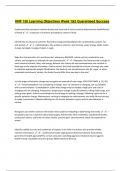HNF 150 Learning Objectives Week 1&2 Guaranteed Success
Understand the concept of nutrient density and state how it can be used to determine the healthfulness
of foods ✔️✔️a measure of nutrients provided per calorie of food
Identify the six classes of nutrients. Recall the energy yield (kcal/gram) for carbohydrate, protein, fat,
and alcohol. ✔️✔️1. carbohydrates, fats, proteins, vitamins, and minerals, water Energy yields: Carbs -
4 cal/g, Fat (lipid)- 9 cal/g), Protein- 4 cal/g
State the characteristics of a nutritious diet; adequacy, BALANCE, calorie control, moderation and
variety, and recognize an example of each characteristic. ✔️✔️Adequacy: the foods provide enough of
each essential nutrient, fiber, and energy; Balance: the choices do not overemphasize one nutrient or
food type at the expense of another; Calorie control: the foods provide the amount of energy you need
to maintain appropriate weight; Moderation: the foods do not provide excess salt, fat, sugar, or other
unwanted constituents; Variety: the foods chosen differ from one day to the next
List the stages of behavior change and recognize an example of each stage. [ON YOUR OWN, p. 18, 20]
✔️✔️Precontemplation: not considering a change. have no intention of changing, see no problems
with current behavior. Contemplation: admit that change may be needed; weigh pros and cons of
changing and not changing. Preparation: preparing to change a specific behavior, taking initial steps, and
setting some goals. Action: committing time and energy to making a change; following a plan set for a
specific behavior change. Maintenance: striving to integrate the new behavior into daily life and striving
to make it permanent. Adoption/Moving on: the former behavior is gone and the new behavior is
routine.
Recognize cues within nutrition information that could be misleading in advertizing and media. ✔️✔️-
too good to be true, suspicions about food supply, testimonials, false credentials, unpublished studies,
persecution claims, authority not cited, motive: persona gain, advertisement, latest innovation/time-
tested
Identify credible sources and credentials of experts in the field of nutrition who provide reliable
nutrition information. ✔️✔️-professional health organizations (American Dietetic Association),
government health agencies(FTC), certain consumer watchdog agencies ( National Council against
Health Fraud), reputable consumer groups (Better Business Bureau)
, Whole foods ✔️✔️these foods are generally considered to form the basis of a nutritious diet; basic
foods. milk and milk products, meats and similar foods such as fish and poultry vegetables including
dried beans and peas; fruits and and grains
Enriched/fortified foods ✔️✔️foods to which nutrients have been added. ex: enriched flour
Functional foods ✔️✔️a food with beneficial physiological or psychological effects beyond providing
essential nutrients
processed foods ✔️✔️foods subjected to any process, such as milling, alteration of texture, addition
of additives, cooking, or others. Depending on the starting material and the process, a processed food
may or may not be nutritious.
6 classes of nutrients ✔️✔️proteins, carbohydrates, fats, water, minerals, and vitamins
essential nutrients ✔️✔️the nutrients the body cannot make for itself from other raw materials;
nutrients that must be obtained from food to prevent deficiencies
nutrient density ✔️✔️a measure of nutrients provided per calorie of food
energy-yielding nutrients ✔️✔️the nutrients the body can use for energy- carbohydrate, fat, and
protein. These also may supply building blocks for body structures
organic nutrients ✔️✔️provide foundation for cell formation; include carbohydrates and other
essential vitamins
inorganic nutrients ✔️✔️important to the development and growth of humans, animals and plants;
minerals
calorie ✔️✔️units of energy. the amount of heat energy necessary to raise the temperature of a
kilogram (a liter) of water 1 degree celcius




